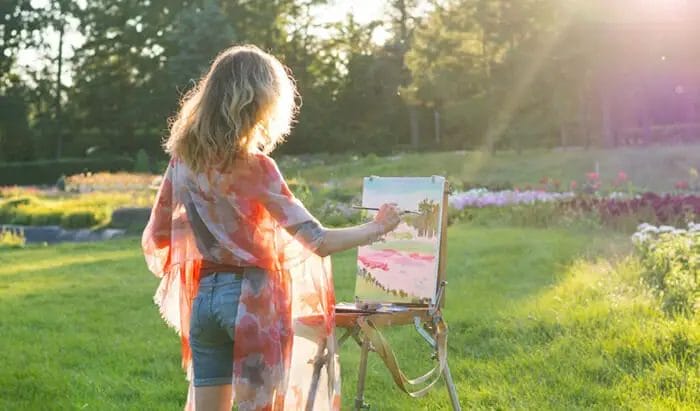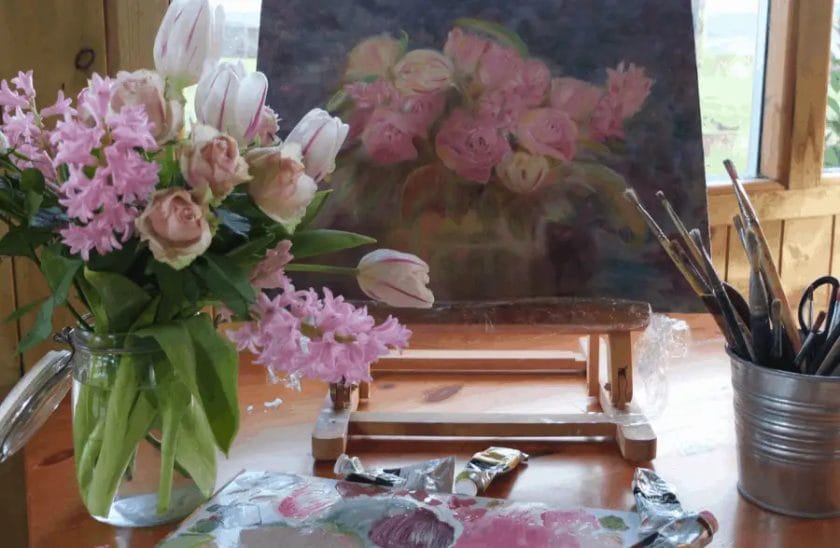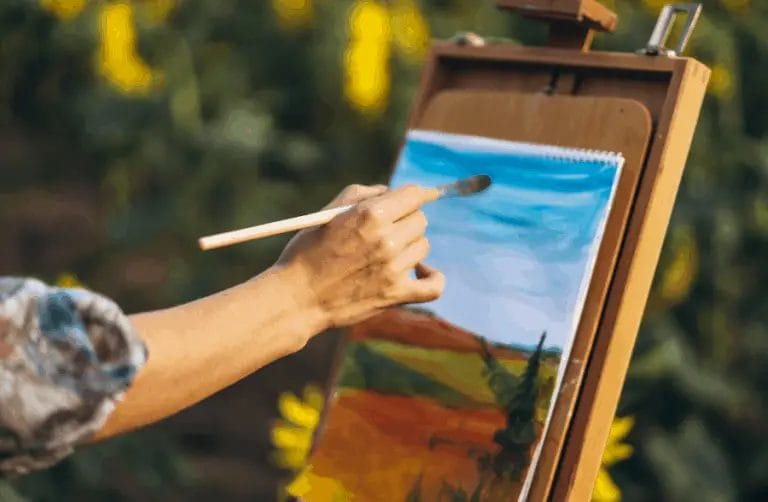Does oil paint dry faster in the sun? Let’s find out!
Oil paint is known for its slow drying time, but exposing it to sunlight can help expedite the process. The heat and UV rays from the sun can accelerate the oxidation process in the paint, causing it to dry faster. However, it’s essential to be cautious when using this method, as excessive heat can lead to cracking or fading of the colors in the paint.
While sunlight can be a helpful tool for speeding up the drying time of oil paint, it’s important to strike a balance and avoid prolonged exposure to extreme heat. Additionally, it’s crucial to consider other factors such as humidity and the type of oil paint used, as they can also affect the drying time.
Ultimately, experimenting with different drying methods and finding what works best for your specific painting techniques and materials is key. So, if you’re looking to dry your oil paint faster, give sunlight a try while keeping the necessary precautions in mind!

The Influence of Sunlight on the Drying Time of Oil Paint
Oil painting is a popular medium that has been used by artists for centuries. One factor that affects the drying time of oil paint is sunlight. In this section, we will explore how sunlight influences the drying process and what artists can do to control it.
When oil paint is exposed to sunlight, it undergoes a chemical reaction known as oxidation. This reaction causes the oil in the paint to harden and dry. Sunlight acts as a catalyst for this process, speeding up the drying time of the paint.
However, it is important to note that prolonged exposure to direct sunlight can have negative effects on oil paint. The UV rays in sunlight can cause the paint to fade or yellow over time. This is why it is recommended to protect oil paintings from excessive sunlight by either displaying them in a controlled environment or using UV-protective varnishes.
While sunlight can accelerate the drying time of oil paint, it is not the only factor that affects drying. Other variables such as temperature, humidity, and the type of pigment used also play a role in how quickly the paint dries.
Temperature can have a significant impact on the drying time of oil paint. Higher temperatures can speed up the oxidation process, causing the paint to dry faster. On the other hand, lower temperatures can slow down drying. Artists should be mindful of the ambient temperature when working with oil paint and adjust their techniques accordingly.
Humidity is another factor that can influence the drying time of oil paint. Higher humidity levels can slow down the evaporation of solvents in the paint, leading to longer drying times. Artists working in humid environments may need to take extra precautions to ensure proper drying, such as using fans or dehumidifiers.
The choice of pigments can also affect the drying time of oil paint. Some pigments dry faster than others due to their chemical composition. For example, earth tones such as burnt sienna or raw umber tend to dry more quickly, while colors like cobalt blue or cadmium red take longer to dry. Artists should be aware of the drying characteristics of different pigments when planning their paintings.
In summary, sunlight can have a significant influence on the drying time of oil paint. While it can speed up the process, prolonged exposure to direct sunlight can also cause damage to the paint. Artists should consider factors such as temperature, humidity, and pigment choice in addition to sunlight when managing the drying time of their oil paintings.

Harnessing the Power of Sunlight to Speed Up Oil Paint Drying
Oil painting is a popular form of artistic expression that has been practiced for centuries. However, one common challenge that artists face when working with oil paints is the drying time. Unlike other types of paint, oil paint dries slowly, which can be frustrating for artists who want to finish their artwork quickly. Fortunately, there is a solution that harnesses the power of sunlight to speed up the drying process.
The key to speeding up the drying time of oil paint is to introduce heat and light, both of which can be provided by the sun. Sunlight contains ultraviolet (UV) rays, which have the ability to break down the oils in the paint and help it dry faster. This technique is especially effective in warm and sunny climates.
To take advantage of this natural drying method, artists can set up their painting supplies in a well-lit area where direct sunlight is available. It is important to position the artwork in a place that receives consistent sunlight throughout the day. Placing the painting near a window or outdoors can provide the necessary exposure to sunlight.
Additionally, artists can incorporate certain techniques to enhance the drying process. One method is to apply thin layers of paint, as thicker layers tend to take longer to dry. By using thin layers, the sunlight can penetrate through the paint more easily, accelerating the drying time.
Another technique is to mix a drying agent or medium into the paint. Drying agents contain chemicals that help evaporate the oils in the paint, resulting in faster drying. Artists should follow the manufacturer’s instructions when using drying agents and be aware that excessive use can affect the quality of the paint.
It is important to mention that although sunlight can speed up the drying time of oil paint, it is essential to properly protect the artwork from direct exposure to sunlight for extended periods. Prolonged exposure to sunlight can cause color fading and other damage to the painting. Artists should consider using UV-protective varnishes or storing the artwork in a shaded area once it has dried.
Benefits of using sunlight to speed up oil paint drying
Using sunlight to accelerate the drying time of oil paint offers several benefits to artists. Firstly, it allows artists to complete their artwork faster, reducing the waiting time between layers or finishing touches. This can be particularly advantageous for artists who work on multiple projects simultaneously or have deadlines to meet.
Secondly, the natural drying method using sunlight is cost-effective and environmentally friendly. Artists do not need to rely on artificial heat sources or specialized equipment, reducing energy consumption and expenses. Sunlight is readily available and accessible to most artists, making it a convenient and sustainable option.
In summary, harnessing the power of sunlight can significantly speed up the drying time of oil paint. By positioning artwork in a well-lit area exposed to direct sunlight, artists can take advantage of the ultraviolet rays to break down the oils in the paint and facilitate faster drying. Incorporating techniques such as using thin layers of paint and adding drying agents can further enhance the drying process. However, artists should be mindful of protecting the artwork from prolonged sunlight exposure to prevent color fading and damage. Overall, leveraging the natural properties of sunlight provides artists with a cost-effective and efficient way to expedite the oil paint drying process.

Exploring the Effects of Sun Exposure on the Drying Time of Oil Paint
Oil paint is a traditional and widely used medium in the world of art. Artists have been using oil paint for centuries due to its unique properties and versatility. One important aspect of working with oil paint is understanding its drying time, as it directly affects the artist’s workflow and the final appearance of the artwork. In recent years, there has been a growing interest in exploring the effects of various factors on the drying time of oil paint, including sun exposure.
When exposed to sunlight, oil paint can undergo certain chemical changes that alter its drying process. The primary cause of these changes is the ultraviolet (UV) radiation present in sunlight. UV radiation has the ability to break down the molecular structure of oil paint, leading to polymerization and cross-linking of the paint film. As a result, the paint dries at a faster rate compared to when it is not exposed to sunlight.
Several studies have been conducted to investigate the effects of sun exposure on the drying time of oil paint. These studies have provided valuable insights into the underlying mechanisms and processes involved. One study found that the presence of UV radiation accelerates the oxidation process of the oil medium, leading to faster drying times. Another study revealed that the intensity and duration of sun exposure play a significant role in determining the drying time. Higher intensities and longer durations of sunlight exposure tend to result in faster drying.
Artists and researchers have also explored the impact of sun exposure on the color of dried oil paint. It has been observed that prolonged exposure to sunlight can cause colors to fade or change over time. This is due to the photochemical reactions that occur within the paint pigments. UV radiation can break down the chemical bonds responsible for the color, resulting in a gradual loss of vibrancy and hue. Therefore, artists who wish to preserve the original colors of their paintings often take precautions to minimize sun exposure.
While sun exposure can speed up the drying time of oil paint, it is important to note that excessive exposure can also have negative effects. Intense sunlight can cause the paint film to dry unevenly, leading to cracking or wrinkling. Additionally, prolonged exposure to UV radiation can weaken the structural integrity of the paint film, making it more susceptible to damage and degradation over time. Therefore, it is crucial for artists to find a balance between utilizing the benefits of sun exposure and protecting the longevity of their artwork.
Summary
The effects of sun exposure on the drying time of oil paint have been the subject of extensive research. Sunlight, particularly the UV radiation it contains, can accelerate the drying process by inducing chemical changes in the paint. Various factors such as intensity and duration of sun exposure can influence the drying time and color stability of oil paint. While sun exposure can be beneficial for artists looking to expedite the drying process, precautions should be taken to prevent adverse effects such as uneven drying, color fading, and structural damage. By understanding and harnessing the effects of sun exposure, artists can enhance their artistic process and create stunning oil paintings.
Utilizing Sunlight as a Natural Drying Agent for Oil Paints
Oil paintings have long been cherished for their vibrant colors and longevity. However, the drying time of oil paints can be a challenge for artists, as it can take weeks or even months for them to fully dry. Traditional methods of drying, such as air drying or using commercial drying agents, can be time-consuming and may affect the quality of the final artwork. In recent years, artists have been exploring alternative methods of drying, one of which is utilizing sunlight as a natural drying agent for oil paints.
Sunlight is a powerful and readily available resource that can expedite the drying process of oil paints. The ultraviolet (UV) rays present in sunlight have a drying effect on the oil-based pigments used in oil paints. When exposed to sunlight, these UV rays initiate a chemical reaction within the paint, causing it to cure and harden at a faster rate.
One of the key advantages of using sunlight as a drying agent is its accessibility. Unlike artificial drying agents, sunlight is free and abundantly available, making it a cost-effective option for artists. Additionally, sunlight offers a natural and gentle drying process, which can help preserve the integrity and vibrancy of the pigments used in the artwork.
Guidelines for Using Sunlight as a Drying Agent
While utilizing sunlight as a drying agent for oil paints can be beneficial, there are certain guidelines that artists should follow to ensure optimal results:
- Choose the Right Conditions: It is important to choose a sunny day with moderate temperature and low humidity for drying oil paintings. Extreme weather conditions, such as high heat or humidity, can negatively impact the drying process and may result in cracking or uneven drying.
- Protect the Artwork: When drying artwork in direct sunlight, it is crucial to protect it from external elements. Placing the painting under a shade or using a UV-filtering sheet can help shield the artwork from potential damage caused by excessive exposure to sunlight.
- Monitor the Drying Process: Regularly check the painting’s drying progress to ensure that it is drying evenly. If any areas of the painting appear to be drying faster than others, you can adjust their exposure to sunlight accordingly to maintain a consistent drying rate.
Benefits of Utilizing Sunlight as a Drying Agent
Choosing sunlight as a natural drying agent for oil paints offers several benefits for artists:
- Improved Drying Time: Sunlight can significantly reduce the drying time of oil paints, allowing artists to complete artworks in a shorter span of time. This can be particularly advantageous for artists working on tight deadlines or those who prefer a quicker drying process.
- Enhanced Color Retention: Compared to artificial drying agents, sunlight provides a gentle drying process that helps retain the colors’ vibrancy and intensity. This can result in a more visually appealing and long-lasting artwork.
- Cost-effectiveness: Using sunlight as a drying agent eliminates the need for expensive commercial drying agents, making it a cost-effective alternative for artists.
- Environmental Friendliness: Opting for a natural drying method like sunlight aligns with environmentally conscious practices, as it reduces reliance on artificial chemicals and energy-consuming drying techniques.
In summary, utilizing sunlight as a natural drying agent for oil paints can offer numerous benefits for artists. With its accessibility, cost-effectiveness, and ability to enhance the drying process while preserving color vibrancy, sunlight provides a viable alternative to traditional drying methods. By following the guidelines and monitoring the drying process, artists can harness the power of sunlight to expedite the drying time of their oil paintings and achieve excellent results.
FAQs
Does oil paint dry faster in the sun?
No, it is not recommended to dry oil paint in direct sunlight. The sun’s heat can cause the paint to dry too quickly, leading to cracking or uneven drying. It is best to let oil paint dry in a well-ventilated room with consistent temperature and humidity levels.
Conclusion
In conclusion, while it may seem like a tempting idea to speed up the drying process of oil paint by exposing it to sunlight, it is not recommended. The sun’s heat and UV rays can cause the paint to dry unevenly, leading to cracking, fading, and other long-term damage. It is best to allow oil paint to dry naturally in a well-ventilated area, away from direct sunlight. Patience is key when it comes to oil painting, as proper drying time ensures the longevity and integrity of the artwork. So, resist the urge to rush and let the paint dry at its own pace for the best results.
